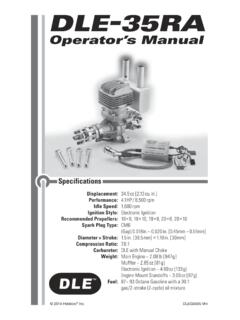Transcription of An Introduction to Shock, Impact, and the Action of ...
1 1. March 2017. An Introduction to Shock, impact , and the Action of viscoelastic Materials Shock is a stimulus applied to a system. A mechanical shock is a sudden acceleration or deceleration. A drop, strike, kick, earthquake or explosions are examples of shock. The term shock is used to describe matter that is subjected to force with respect to time. The impulse can be short making the change in velocity quite large. Shock can be viewed as a vector that has units of a rate of change of velocity. The unit g represents multiples of the acceleration of gravity. A shock load is one way destructive vibrations are introduced into a system. 2. An impact is an extreme force or shock applied over a short time period. As when two or more objects collide. This type of acceleration or force has a greater effect than a lower force applied over a longer period of time. The effect can be devastating and depends essentially on the relative velocity of the bodies to one another.
2 At customary speeds an object struck by a projectile will deform. The deformation works to absorb a percentage of the force applied. However, a high- velocity impact does not allow sufficient time for these deformations. The struck material or object behaves as if it was more fragile, and the better part of the applied force works toward fracturing the material . Damaging Effects of Shock and impact Forces Physical (mechanical) shock can damage an entire object or a single element of that object. In the featured image above the entire light bulb may be destroyed by shock or just the filament within. Fracture damage occurs when two or more items impact each other or external forces impact an object. A ductile item can be bent by impact or shock. Mechanical failure can occur with numerous repeated low-level shocks . Cumulative minor damage from several or repeated shocks will eventually result in instability. Service life of a product can be shortened by shock or impact and reliability reduced.
3 Shock can invalidate the results from precision scientific instruments Some materials such as explosives may detonate from mechanical shock or impact Connections can be weakened or separated by shock. Based on the type of inputs present in the application shock attenuation and impact (absorbing) components can be comprised of: mechanical shock absorbers, linear dampers, spring isolators, elastomeric isolators, air springs or structural damping treatments. Additionally, viscoelastic material and components work to isolate impact , attenuate shock and damp vibration. The geometry, thickness and durometer of the material can be engineered to meet specific design requirements. viscoelastic materials exhibit both viscous (liquid) and elastic (solid). characteristics when under load. Viscous materials resist shear flow and strain linearly (with time) under stress or load. Elastic materials strain when stretched but return to their original state once the stress is removed.
4 viscoelastic materials have elements of both liquid and solid properties and exhibit time- dependent strain. 3. Shock, impact and viscoelastic Materials Glossary of Terms Acceleration a vector quantity that specifies the time rate of change of velocity Amplitude the maximum value of a sinusoidal quantity ( acceleration, displacement). Attenuation is the gradual loss in intensity of any kind of flux through a medium Center of Gravity the point of support at which a body is in balance Damping dissipation of energy in an oscillating system. Limits maximum amplitude at isolator natural frequency Deflection Is the distance an elastic body or spring moves when subjected to a static or dynamic force Displacement the change of position of a body, usually measured form the mean position of rest. Displacement is related to acceleration by frequency Foundation is a structure that supports the gravity load of a mechanical system Fragility the amount of shock, impact or vibration that a piece of equipment can endure.
5 Isolation systems are designed to limit the transmission of forces to the stated fragility Frequency the number of times the motion repeats itself per unit of time. The unit cycle per second is called Hertz (Hz). Hysteresis a retardation of an effect when the forces acting upon a body are changed as if from viscosity or internal friction. Sorbothane turns mechanical energy into a small amount of heat. As the material is deformed, molecular friction generates heat. This lost energy is hysteresis Isolation Is a reduction in the capacity of a system to respond to an excitation. Achieved by the use of a resilient element between the equipment and mounting surface Mass weight in pounds divided by the gravitational constant, (g= or 386 in/sec2). Natural Frequency the number of cycles of oscillation that occurs in a time period when moved from a normal resting position and allowed to vibrate freely Periodic Motion a motion that repeats itself at definite intervals of time Shape Factor the loaded area over the unloaded area of a shock or vibration mount 4.
6 Shock a condition where the equilibrium of a system is disrupted by a sudden acceleration or deceleration, or by a sudden change in the direction or magnitude of a velocity vector Shock Absorber a device, component or material that dissipates energy to modify the response of a mechanical system to applied shock Shock Mount or Isolator Is a resilient support that isolates a system from shock motion or excitation Shock Pulse primary disturbance characterized by a rise and decay of acceleration in a relatively short time Spring Rate/Stiffness the force required to deflect an isolator a unit distance. Stiffness is the slope of a curve showing force on the Y-axis and deflection on the X-axis. Units typically are pounds/inch Structural Damping reduces the vibration of resonating surfaces that radiate. Damping is accomplished by affixing a material directly to the vibratory surface. This material converts the mechanical vibration energy into to a minimal amount of heat energy Tangent of Delta a dimensionless term that expresses the out-of-phase time relationship between a shock impact or vibration and the transmission of the force to the support.
7 It can also be known as tan delta, the damping coefficient, or the loss factor. The higher the tangent of delta, the better the material performance with regards to shock and vibration Transmissibility percentage of vibratory force or motion transmitted to its support Velocity a vector quantity that specifies the time rate of change of displacement with respect to a reference time viscoelastic a material that exhibits properties of both liquids (viscous solutions) and solids (elastic materials). Because viscoelastic behavior is useful in shock and vibration applications many materials claim to be viscoelastic . Technically, they are correct but many of these materials have only trace viscoelastic properties. A viscous material (a liquid) deforms under load and transmits forces in all directions. It distributes a small amount of pressure over a large area. It does not recover its shape when the load is removed. An elastic material deforms under load and returns to its original shape when the load is remove 5.
8 The Unique Properties of Sorbothane . Sorbothane is a solid that distorts easily and recovers completely. It can cope with energy in more than one direction. Sorbothane has the characteristics of both viscous and elastic materials. A proprietary viscoelastic polyurethane Sorbothane offers engineers unique opportunities to attenuate shock, isolate vibrations and damp noise in mechanical systems. Sorbothane is a thermoset, polyether-based polyurethane solid that flows like a liquid under load while retaining excellent memory. Sorbothane is formulated for enhanced viscoelastic properties. Sorbothane is consistently effective over a wide temperature range (-29 to + 71 degrees Celsius). Viscous materials (liquids) deform under load and transmit force in all directions. They do not recover their shape when the load is removed. An elastic material deforms under load and returns to its original shape after the load is removed. The energy from a Sorbothane deflection is converted into a small amount of heat, which dissipates from the material .
9 The result is a unique system with the ability to absorb shock, isolate vibration and damp unwanted noise. Because Sorbothane is a non-Newtonian material stress is not proportional to strain and mechanical energy is lost by conversion to heat. The response of Sorbothane to a load is highly dependent on the rate of force application (frequency dependent responses). Sorbothane is highly damped which makes it particularly desirable for difficult applications, which require operation near or at resonant frequencies. Sorbothane is available as custom-molded parts, select standard shapes and sheet stock in a variety of thickness and sizes. Parts can be specified in durometers ranging from 30 to 80 on the Shore 00 scale. The most effective static deflection for Sorbothane with a shape factor between and is in the range of 10-20%. 6. Sorbothane Performance Curves Sorbothane turns mechanical energy into heat. As the material is deformed, molecular friction generates heat.
10 This lost energy is called hysteresis. Energy is translated perpendicularly away from the axis of incidence and its effect is pushed nearly 90 out of phase from the original disturbance. This phase shift, known as Tan Delta , is a measure of Sorbothane's damping effectiveness. The higher the value of Tan Delta, the greater the amount of damping that occurs. CONTROLLING SHOCK WITH SORBOTHANE . High damping in a polymer reduces the impulse peak of a shock wave over a longer time frame. Sorbothane reduces the impact force up to 80% and brings the mass slowly to rest. A gradual deceleration affords better protection of delicate equipment. Sorbothane exhibits very low rebound when compared to other materials. 7. impact ABSORPTION USING SORBOTHANE . The graph below shows the high hysteresis necessary for efficient impact absorption. By comparing the area under the curves, Sorbothane removes more of the impact energy from the system. Natural rubber is more elastic and returns energy to the system.




